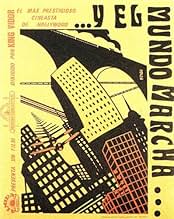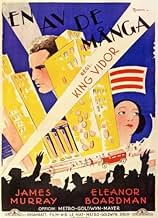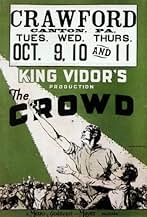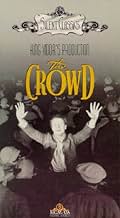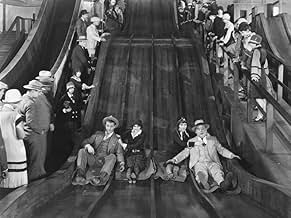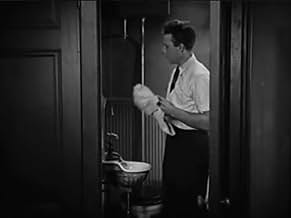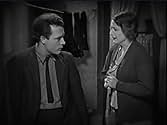NOTE IMDb
8,0/10
9,8 k
MA NOTE
La vie d'un homme et d'une femme ensemble dans une grande métropole impersonnelle à travers leurs espoirs, leurs luttes et leurs chutes.La vie d'un homme et d'une femme ensemble dans une grande métropole impersonnelle à travers leurs espoirs, leurs luttes et leurs chutes.La vie d'un homme et d'une femme ensemble dans une grande métropole impersonnelle à travers leurs espoirs, leurs luttes et leurs chutes.
- Réalisation
- Scénario
- Casting principal
- Nommé pour 2 Oscars
- 4 victoires et 2 nominations au total
John D. Bloss
- Boy on Fence
- (non crédité)
Roy Bloss
- Boy on Fence
- (non crédité)
Sidney Bracey
- John's Supervisor
- (non crédité)
Johnny Downs
- John - Age 12
- (non crédité)
Sally Eilers
- Party Girl at Bert's Place
- (non crédité)
Joseph W. Girard
- Member of Board of Directors
- (non crédité)
Pat Harmon
- Truck Driver
- (non crédité)
Chris-Pin Martin
- Worker in Hallway
- (non crédité)
Claude Payton
- Undetermined Secondary Role
- (non crédité)
Avis à la une
Silent drama about John (James Murray) and Mary (Eleanor Boardman) meeting in NYC, falling in love and marrying. John wants to make it big--to be somebody. He looks down on those who, he feels, have failed. But, after marriage and two kids, he's still stuck in the same dead-end job and sees no way out. Then tragedy strikes and John starts to crack.
A failure when first released (it's easy to see why--it's very depressing) but now considered a masterpiece. The story is grim but the ending is happy and realistic. Murray and Boardman give superb performances (especially Murray during a scene with his son on a bridge) and King Vidor's direction is superb. The visuals in this film are decades ahead of their time. His use of the crowds and the individuals lost among them are just great.
Hard to describe but a definite must-see. Just don't expect a barrel of laughs.
A failure when first released (it's easy to see why--it's very depressing) but now considered a masterpiece. The story is grim but the ending is happy and realistic. Murray and Boardman give superb performances (especially Murray during a scene with his son on a bridge) and King Vidor's direction is superb. The visuals in this film are decades ahead of their time. His use of the crowds and the individuals lost among them are just great.
Hard to describe but a definite must-see. Just don't expect a barrel of laughs.
The most remarkable thing about 'The Crowd (1928)' is that is manages to cover so much emotional ground. John (James Murray) is a young man who knew from an early age that he would become somebody special, that he would stand out from the crowd. At age 21, he travels to New York, the towering metropolis introduced via a montage of impressive high- angled shots that resemble Robert Florey's 'Skyscraper Symphony (1929).' John joins the accounting sector of a large insurance firm, and studiously assures himself that he need only work his way up. Years pass. John marries, has two children. It takes him five years to realise that he has become what he swore never to become: a member of The Crowd.
Vidor's message is a double-edged sword. Early in the film, The Crowd is something to be loathed: the camera, in a virtuoso display of technical brilliance, swoops down upon a seemingly-endless room of seated accountants, each man turning pages in mechanical unison. (Billy Wilder later paid homage to this scene in 'The Apartment (1960)'). But when John finally determines to break free from The Crowd, his world falls apart around him – he can't maintain a job, his wife threatens to leave him, he loses his dignity. The film's ending is intriguing in its ambiguity: John is absorbed into the crowds of a laughing theatre audience.
Is it a happy ending, an embracing of conformity? Is it ironic, an acknowledgment of mass delusion? Is Vidor integrating his character into the cinema audience? In 'The Bicycle Thief (1948),' a similar disappearance into the crowd is viewed as tragic, but here I'm not so sure. F.W. Murnau's 'The Last Laugh (1924)' told a similar tale, depicting the bleak prospects of a working-class doorman, played by Emil Jannings. UFA studio thwarted that film by enforcing a ludicrous happy ending that Murnau included only with a snide introductory title card. M-G-M also toyed with a happy ending to 'The Crowd,' but fortunately Vidor's version ultimately won out, a conclusion genuinely unsettling in its uncertainty, and sure to inspire discussion.
Vidor's message is a double-edged sword. Early in the film, The Crowd is something to be loathed: the camera, in a virtuoso display of technical brilliance, swoops down upon a seemingly-endless room of seated accountants, each man turning pages in mechanical unison. (Billy Wilder later paid homage to this scene in 'The Apartment (1960)'). But when John finally determines to break free from The Crowd, his world falls apart around him – he can't maintain a job, his wife threatens to leave him, he loses his dignity. The film's ending is intriguing in its ambiguity: John is absorbed into the crowds of a laughing theatre audience.
Is it a happy ending, an embracing of conformity? Is it ironic, an acknowledgment of mass delusion? Is Vidor integrating his character into the cinema audience? In 'The Bicycle Thief (1948),' a similar disappearance into the crowd is viewed as tragic, but here I'm not so sure. F.W. Murnau's 'The Last Laugh (1924)' told a similar tale, depicting the bleak prospects of a working-class doorman, played by Emil Jannings. UFA studio thwarted that film by enforcing a ludicrous happy ending that Murnau included only with a snide introductory title card. M-G-M also toyed with a happy ending to 'The Crowd,' but fortunately Vidor's version ultimately won out, a conclusion genuinely unsettling in its uncertainty, and sure to inspire discussion.
Restored with a very nice score,"the crowd" hasn't aged a bit.The topic is as relevant today as it was in 1928.Do have a look at the first pictures of "the apartment" (1960) or the last ones of "working girl"(1988)and you'll know what I mean. John Sims tries to beat the crowd,this crowd that follows him everywhere,at work,in the streets,at the fair or on the beach.He doesn't even realize his condition :you should see him laughing at the people on the street,behaving like sheep.It's always someone else,his wife says,take a look at yourself.
The secondary characters are wonderfully depicted:the well-padded buddy,the mother and brothers-in-law always contemptuous,always putting John down.Lots of sequences are memorable,now comic,now tragic:the tiny flat where even the bed must be folded,the huge office where employees are doing the same job at the same time,where everybody acts alike when they leave their job,like some kind of ballet.
John Sims is the embodiment of the American dream,but it has an universal appeal.When he was born,his father promised he would have good prospects,he would become someone big.King Vidor does not show the relationship father/son cause the father disappears when John is still a boy,but we can easily imagine it.So Sims thought NY was depending on him,and he discovers that he will be a wash-out all his life.If it weren't for his little boy who still believes in him(Vittorio de Sica will remember it for his "bicycle thief",he would throw himself under a train.
The cinematography is prodigious;two examples : The father is dead, the boy is climbing a stair : stunning high angle shot,enhancing his awful pain. On the contrary,the skyscrapers are filmed from below,showing how lost a human being can feel in this steel and glass world .
A detail :the hysterical/historical joke at the fair will be used again by the Beatles themselves in their "magical mystery tour" home-made movie.
1928:the silent era was coming to an end but we had not heard the last of it.
The secondary characters are wonderfully depicted:the well-padded buddy,the mother and brothers-in-law always contemptuous,always putting John down.Lots of sequences are memorable,now comic,now tragic:the tiny flat where even the bed must be folded,the huge office where employees are doing the same job at the same time,where everybody acts alike when they leave their job,like some kind of ballet.
John Sims is the embodiment of the American dream,but it has an universal appeal.When he was born,his father promised he would have good prospects,he would become someone big.King Vidor does not show the relationship father/son cause the father disappears when John is still a boy,but we can easily imagine it.So Sims thought NY was depending on him,and he discovers that he will be a wash-out all his life.If it weren't for his little boy who still believes in him(Vittorio de Sica will remember it for his "bicycle thief",he would throw himself under a train.
The cinematography is prodigious;two examples : The father is dead, the boy is climbing a stair : stunning high angle shot,enhancing his awful pain. On the contrary,the skyscrapers are filmed from below,showing how lost a human being can feel in this steel and glass world .
A detail :the hysterical/historical joke at the fair will be used again by the Beatles themselves in their "magical mystery tour" home-made movie.
1928:the silent era was coming to an end but we had not heard the last of it.
Like most of the silent tragedies I've seen (and there haven't been many), "The Crowd" was hard to like. That didn't stop it from being a finely directed and acted drama. Like any film from any era that avoids the traps of trend-conscious filmmaking, "The Crowd" was built to last. When you make a movie with a good, solid story and inspire the cast to give brilliant performances, it's difficult to go wrong.
It's not a fun movie -- most of the time we're spent watching James Murray shoot himself in the foot, scene after scene. He's a really pathetic creature, but the director, King Vidor, portrays him and his story without passing judgment.
Worth the price of admission alone, Vidor's eye for detail in old New York City. In a justly famous montage and tracking shot near the beginning, he shows us Gotham so well, and in such great detail, that hardly a director since has been able to match him. His nomination of Best Director at the first Academy Awards was completely deserved (and his loss to Frank Borzage for the creaky "7th Heaven" was, arguably, the first of Oscar's major blunders.)
It's a bleak world view, that's for sure, but it keeps your attention and fills your eye.
It's not a fun movie -- most of the time we're spent watching James Murray shoot himself in the foot, scene after scene. He's a really pathetic creature, but the director, King Vidor, portrays him and his story without passing judgment.
Worth the price of admission alone, Vidor's eye for detail in old New York City. In a justly famous montage and tracking shot near the beginning, he shows us Gotham so well, and in such great detail, that hardly a director since has been able to match him. His nomination of Best Director at the first Academy Awards was completely deserved (and his loss to Frank Borzage for the creaky "7th Heaven" was, arguably, the first of Oscar's major blunders.)
It's a bleak world view, that's for sure, but it keeps your attention and fills your eye.
This is easily on the best silent films that I have seen. I got caught up in the story right from the beginning. To a degree, this is a story of the great mass of people that make up "The Crowd." As is pointed out in the beginning, a story of a man who is indispensible to New York (as most think.) He isn't. He thinks he is better than those he works with and is constantly waiting for 'his ship' to come in (which doesn't). In the end he almost loses his wife because of that.
I really enjoyed the scene early in the movie when he and a friend are going to Coney Island with two girls and both stop to watch the girls go up stairs so they can look at their legs. Probably somewhat risque' in 1928.
The film really stands out for the editing. Especially when you remember that this was made in 1928. It is used to also give you excellent views of New York and life in 1928.
I will see this one again and again.
I really enjoyed the scene early in the movie when he and a friend are going to Coney Island with two girls and both stop to watch the girls go up stairs so they can look at their legs. Probably somewhat risque' in 1928.
The film really stands out for the editing. Especially when you remember that this was made in 1928. It is used to also give you excellent views of New York and life in 1928.
I will see this one again and again.
Le saviez-vous
- AnecdotesSeveral years after the film was made, alcoholism had taken its toll on lead actor James Murray, who was reduced to panhandling in the street. Ironically, one of the passers-by he solicited for money turned out to be King Vidor, who offered him a part in the film's semi-sequel, Notre pain quotidien (1934). Murray declined the offer, thinking it was only made out of pity. He died in 1936 at the age of 35 in a drowning incident. Vidor was sufficiently compelled to write his life story as an unrealized screenplay, which he called "The Actor".
- GaffesAfter John sprays himself with milk when opening the bottle, his clothes go from covered with milk to clean from one shot to the next.
- Citations
Title Card: The crowd laughs with you always... but it will cry with you for only a day.
- Versions alternativesThere is an Italian edition of this film on DVD, distributed by DNA srl, "LA FOLLA (1928) + LA GRANDE PARATA (1925)" (2 Films on a single DVD), re-edited with the contribution of film historian Riccardo Cusin. This version is also available for streaming on some platforms.
- ConnexionsEdited into Quand on est belle (1931)
Meilleurs choix
Connectez-vous pour évaluer et suivre la liste de favoris afin de recevoir des recommandations personnalisées
- How long is The Crowd?Alimenté par Alexa
Détails
- Date de sortie
- Pays d’origine
- Langue
- Aussi connu sous le nom de
- The Crowd
- Lieux de tournage
- Coney Island, Brooklyn, Ville de New York, New York, États-Unis(nighttime establishing exterior shots)
- Société de production
- Voir plus de crédits d'entreprise sur IMDbPro
- Durée
- 1h 38min(98 min)
- Couleur
- Mixage
- Rapport de forme
- 1.33 : 1
Contribuer à cette page
Suggérer une modification ou ajouter du contenu manquant

